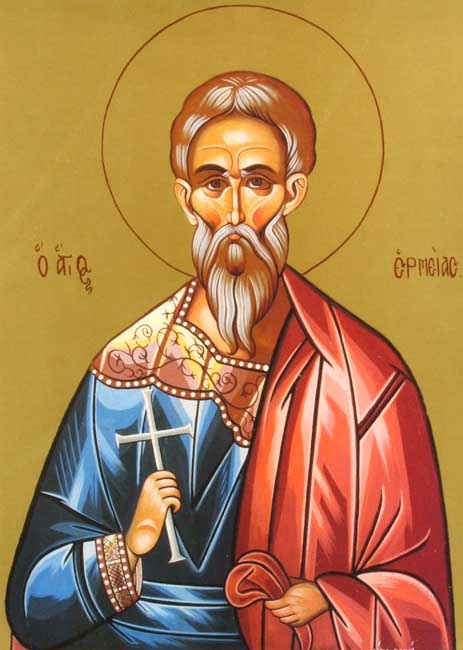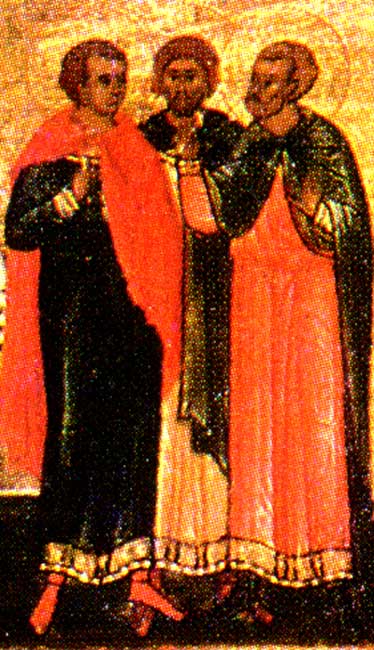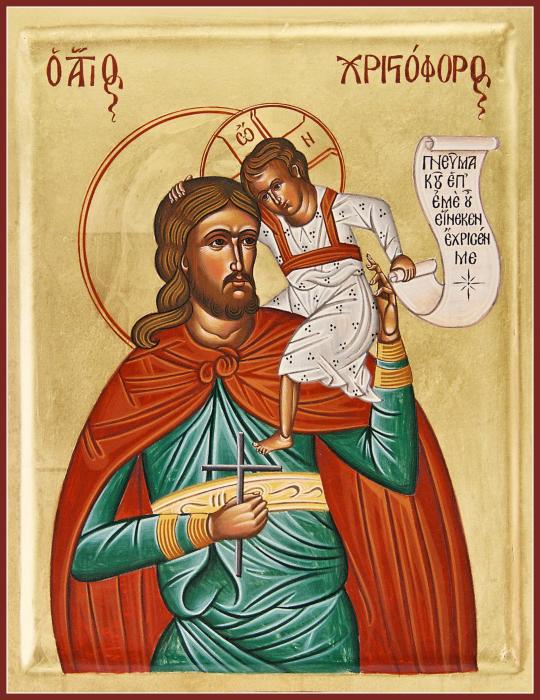The Holy Apostle Simon the Zealot
The holy, glorious and all-laudable Apostle Simon the Zealot was one of the Twelve Apostles of Jesus Christ, referenced in Matthew 10:2-4 and other places in Holy Scripture. His feast day is May 10 (October 28th in Roman). According to legend, he preached in various places in the Middle East and suffered martyrdom by being sawed in two; in art, he is depicted with a saw, the instrument of his death, or a book, symbolic of his zeal for the Law.
The apostle Simon was the least known, and one must constrain himself lest he say the least important, of all the apostles. In all Sacred Scripture there is nothing else said of him beyond the mention of his name. And even this name, Simon-from the Hebrew, shim'on, literally, "heard"-he had to share with another Simon in the circle of the apostles...
We know nothing certain, absolutely nothing certain about Simon's apostolic works. Simon, the unknown apostle, is the patron of the countless Christians who go through life without fame, without a name. He is the patron of the army of unknown workers in the vineyard of the Lord, who toil in the last places for the kingdom of God. He is the patron of the unknown soldiers of Christ, who struggle on the disregarded and thankless fronts. No one notices, no one praises, no one rewards this obscure and often misunderstood apostles-no one except the Father, who sees through all obscurity, who understands all misjudgments.
Simon, the Unknown Zealot
Legends concerning the apostle Simon are as contradictory as those concerning his brother Jude Thaddeus. The most plausible of all, however, is the account that Simon, after the death of his oldest brother, James, in the year 62, succeeded him as bishop of Jerusalem.
The Church historian Eusebius recored Hegesippus' statement, made around the middle of the second century, that a Simeon, son of Clopas, was the second bishop of Jerusalem. Nicephorus Callistus also listed this Simeon as the second bishop of Jerusalem. The first account states that this apostle held his office for twenty-three years; the second, for twenty-six years. The validity of this information is strengthened by an old Abyssinian tradition. Accordingly to this, the apostle Simon the Zealot, after zealously laboring in Samaria, become bishop of Jerusalem, and there he suffered martyrdom on the cross. The Roman Breviary, however, observes the feast of the apostle Simon separately on October 28th, and that of a Simeon, bishop of Jerusalem, on February 18.
Simon's apostolic labors as bishop of Jerusalem coincided with the siege, conquest and destruction of the Holy City. Simon might often have envied James, his martyred brother and predecessor, who was spared the grueling experience of watching the devastation of the holy places. Christ had warned,
"And when you see Jerusalem being surrounded by an army, then know that her desolation is at hand. Then let those who are in Judea flee to the mountains; and let those who are in her midst go out...
Remembering this, Simon promptly fled with his flock of the faithful to the pagan city of Pella in Perea, where the threat of war was not imminent.
This was the first evacuation of Christian refugees commanded by the Good Shepherd Himself, out of deep concern for His faithful flock.
Legends have portrayed this reserved Simon crossing many different and distant lands.
The "Acts of Simon and Jude" identified the scene of Simon's apostolic labors as Babylonia and Persia (as already explained in the previous chapter on Jude Thaddeus). Centering their activity in Babylon, Simon and Jude journeyed through the twelve provinces of the Persian Empire. Yet even in these legends the shadow of the first Simon, Peter, can be traced. It was in "Babyon"-to be understood as a cryptic designation for Rome-that Peter wrote his first Epistle at the time when this Babylonian city was besieged by vice, false teaching, and immorality. Perhaps, therefore, legend has attributed the real Babylon to Simon the Zealot as the field of his missionary activity because Simon Peter had worked in the symbolic Babylon.
According to these legends, Simon suffered a martyr's death in the "city of Suanir". Yet a Persian city with this name is not known. There is the possibility that some connection existed between Suanir and the "Suanen" in Colchis, an ancient country on the eastern shore of the Black Sea in Transcaucasia.
Simon's special grace was to persevere in Christ, as Christ increased and he decreased.
Many who must work in obscurity lose their ardor and zeal. We would do well to follow the example of Simon by going out into the world to become unknown, while Christ becomes known.
Profound, therefore, is the lesson to be learned from this simplest of all the apostles: when we are not thanked, not remembered, not known, we should rejoice for the sake of Christ, and not only to persevere in, but increase, our zeal.
"Take heed not to practice your good before men, in order to be seen by them; otherwise you shall have no reward with your Father in heaven.
"Therefore when thou givest alms, do not sound a trumpet before thee, as the hypocrites do in the synagogues and streets, in order that they may be honored by men. Amen I say to you, they have had their reward"
Mind the things that are above, not the things that are on earth. For you have died and your life is hidden with Christ in God. When Christ, your life, shall appear, then you too will appear with him in glory.
The following paragraph is taken from Leonard Foley, O.F.M. from his book Saint of the Day. Simon is mentioned on all four lists of the Apostles. On two of them he is called "the Zealot". The Zealots were a Jewish sect which represented an extreme of Jewish nationalism. For them, the messianic promise of the Old Testament meant that the Jews were to be free and independent nation. God alone was their king, and any payment of taxes to the Romans-the very domination of the Romans-was a blasphemy against God. No doubt some of the Zealots were the spiritual heirs of the Maccabees, carrying on their ideals of religion and independence. But many were the counterparts of modern terrorist. They raided and killed, attacking both foreigners and collaborating Jews. They were chiefly responsible for the rebellion against Rome which ended in the destruction of Jerusalem in A.D 70.
The following links provides insight on both Sts Simon and Jude:
http://www.catholic-forum.com/saints/golden296.htm
Apostles.com
http://www.newadvent.org/cathen/13796b.htm



















